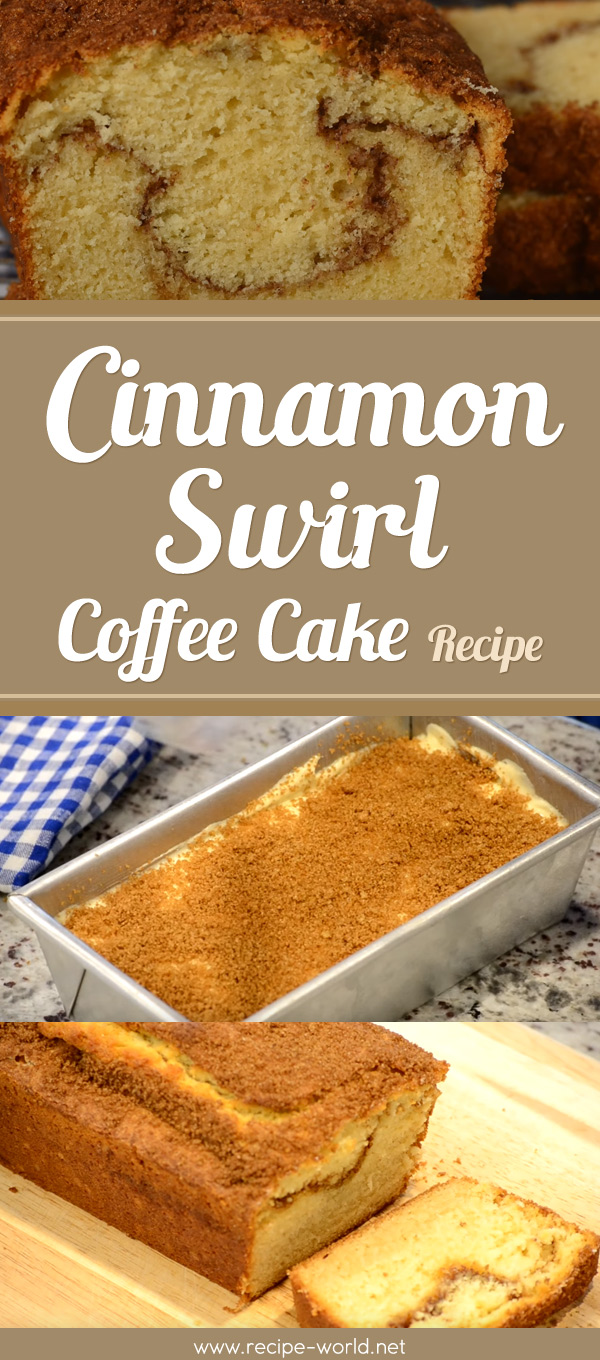Coffee cake is a moist, tender cake typically flavored with cinnamon, nuts or fruits and topped with some kind of crumb topping or glaze. Coffee cake does not contain coffee but the name refers to how it is eaten – that is, with coffee. According to food historians, the Danish came up with the earliest versions of coffee cake. This was around the 17th century when coffee was introduced to Europe and these cakes were a natural accompaniment.
Here is a recipe for a coffee cake with a simple cinnamon-sugar swirl that is also used as the light crumb topping. This cake may be served warm or cold and it is not only perfect with a cup of coffee but also with tea, milk or even ice cream. Serve this for breakfast, brunch, afternoon snack, dessert or even a late night snack.
Ingredients:
This recipe takes about 20 to 25 minutes to make. The cake needs to bake for 55 minutes in the oven. Serves 1 loaf.
Cinnamon Sugar Topping:
• ¼ cup of firmly packed light brown sugar
• 1 ½ tsp ground cinnamon
Coffee Cake:
• 2 cups of all-purpose flour
• 1 tsp baking powder
• ½ tsp baking soda
• ½ tsp salt
• ½ cup of unsalted butter, at room temperature
• 1 cup of granulated white sugar
• 2 large eggs, at room temperature
• 1 tsp pure vanilla extract
• 1 cup of buttermilk, at room temperature
Instructions:
To make the cinnamon sugar topping, mix together brown sugar and cinnamon powder in a small bowl. Set this aside.
In a large bowl, mix all dry ingredients together flour, baking soda, baking powder, and salt. Set this aside.
Using a stand mixer set on medium speed, cream butter until smooth.
Add granulated white sugar and pure vanilla extract.
Beat on medium-high speed until light and fluffy. About 3 to 4 minutes.
Using a spatula, give the sides of the bowl quick scrape.
Add an egg at a time while beating on medium-high speed until each egg is well incorporated in the butter-sugar mixture.
Using low speed, add dry-ingredients mixture alternately with buttermilk. Start and end with the dry ingredients.
Pour half of the batter into a greased loaf pan lined with parchment paper.
Using a spatula, spread the batter to even it out in the pan.
Sprinkle half of the cinnamon-sugar mixture on top.
Pour in the rest of the batter and even it out.
Sprinkle the rest of the cinnamon-sugar mixture on top.
Using a wooden skewer, gently draw swirls through the batter.
Bake in a preheated oven at 350°F for 55 minutes.
Take the cake out from the oven and let it cool for about 10 minutes.
To unmold, gently run a knife on the sides of the cake to make sure nothing sticks to the pan.
Gently flip the pan to release the cake and place it on a cake rack.
Let this cool for 5 more minutes.
Slice the cake using a serrated or bread knife and serve.
Ideas And Tips:
• You may use a hand mixer if you don’t have a stand mixer.
• You may also add any chopped nuts of your choice. A few ideas on how to add the nuts include; mixing the nuts in your batter before pouring into the pan, adding them after you sprinkle the cinnamon-sugar mixture or simply as toppings before baking the cake.
• To make a substitute for buttermilk, mix 1 tbsp white vinegar, cider vinegar, or lemon juice into 1 cup of whole or reduced-fat milk. Let the mixture stand at room temperature for 10 minutes before using.

images – https://www.youtube.com/watch?v=st5UynxoWNg
😳 What Tinnitus Does To Your Brain Cells (And How To Stop It)
After 47 years of studies and countless brain scans done on more than 2,400 tinnitus patients, scientists at the MIT Institute found that in a shocking 96% of cases, tinnitus was actually shrinking their brain cells.
As it turns out, tinnitus and brain health are strongly linked.
Even more interesting: The reason why top army officials are not deaf after decades of hearing machine guns, bombs going off and helicopter noises…
Is because they are using something called "the wire method", a simple protocol inspired by a classified surgery on deaf people from the 1950s...


